Vee-Jay Records: MONO
#01 Introducing The Beatles Ver.1 (VJLP-1062/VJLPS-1062)
(Update: 5th. December 2023)


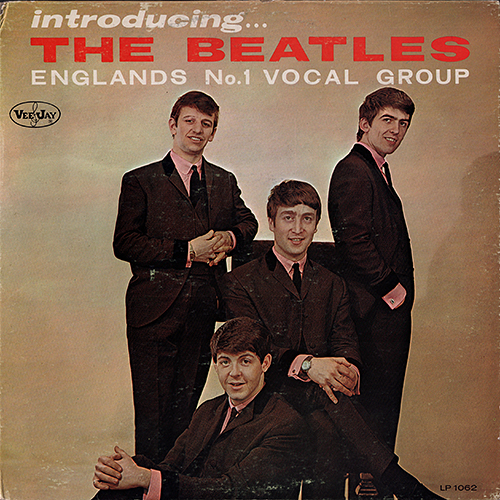 Vee-Jay Records Sleeve |
INDEX |
| TITLE | INTRODUCING THE
BEATLES (Ver.1) |
||||
| CATALOG NUMBER | VJLP-1062 |
||||
| RELEASE DATE | January 1964? /Second Press (First press: 10th. January 1964) | ||||
| TRACK LISTING | SIDE 1 | SIDE 2 | |||
| I Saw Her Standing There |
P.S. I
Love You |
||||
| Misery |
Baby It's You |
||||
| Anna |
Do You Want To Know A Secret ? |
||||
| Chains |
A Taste Of Honey |
||||
| Boys |
There's A Place |
||||
| Love Me
Do |
Twist And Shout |
||||
| FRONT -->Click! | BACK -->Click! | SIDE 1 -->Click! | SIDE 2 -->Click! | DISK | |
 |
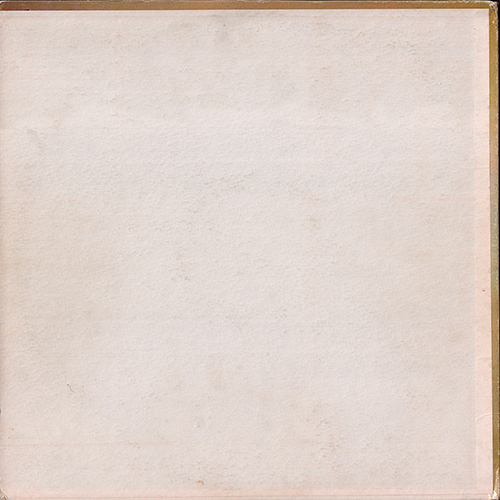 |
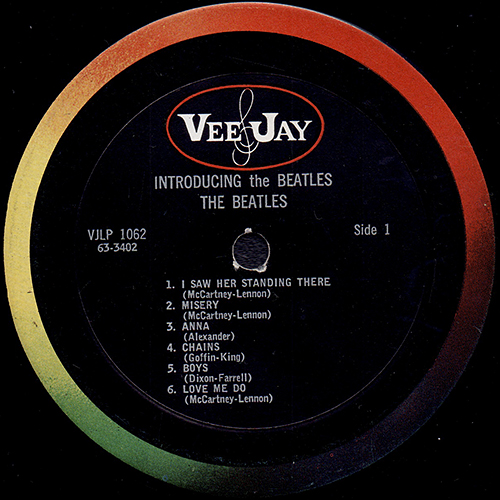 |
 |
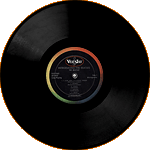 |
|
| INNER SLEEVE |
FRONT AND
BACK COVER CLOSE UP |
||||
| FRONT -->Click! | BACK -->Click! | ||||
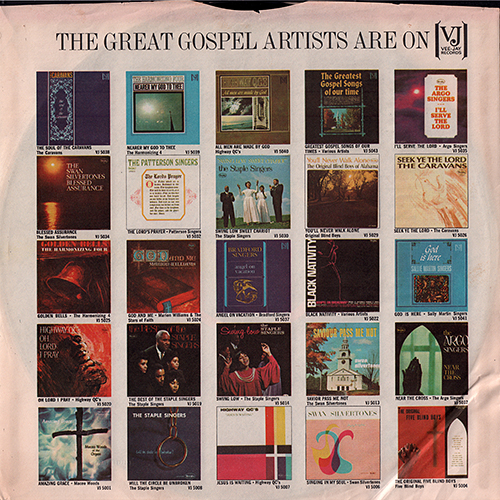 |
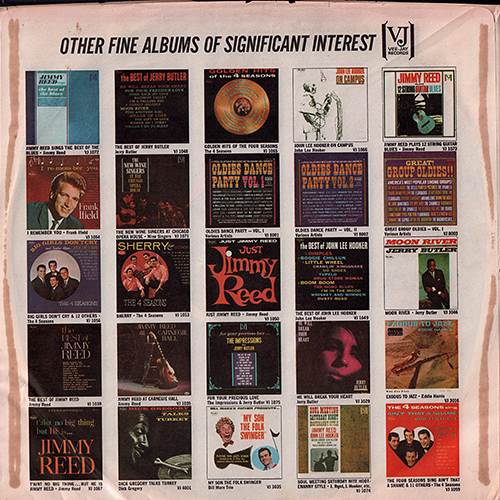 |
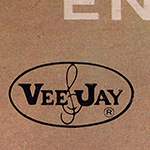 |
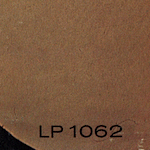 |
The mono covers have the slick positioned so that the number LP 1062 appears in the lower right hand corner. | |
| BACK COVER CLOSE UP | |||||
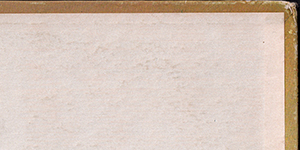 |
The
second
variation of the albumfs back cover: The second variation is a glossy blank white slick. This variation is known among collectors as the "Blank Back" cover. Blank Back covers (mono and stereo) have two noticeable but minor variations: with "Printed in U.S.A." on its front cover slick. / later front cover slick without "Printed in U.S.A." |
||||
| LABEL CLOSE UP | |||||
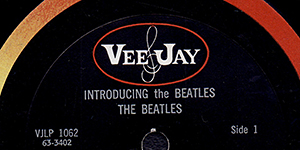 |
It has a black label featuring an outer rim colorband and the oval logo. |  |
|||
| "INTRODUCING the
BEATLES" in small print on the center of the label. |
|||||
| LABEL CLOSE UP | |||||
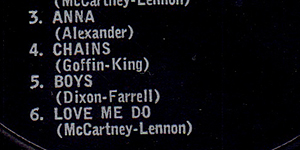 |
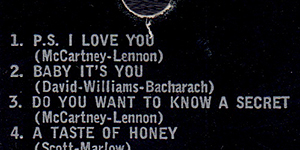 |
Has left justified song
titles and songwritersf credits. |
|||
| LABEL CLOSE UP | |||||
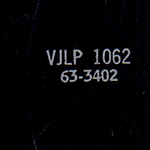 |
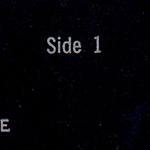 |
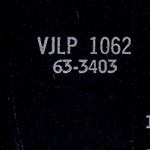 |
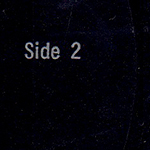 |
The words gLong Playingh
and gMicrogrooveh do not appear on the label. |
|
|
OTHER ITEM
|
|||||
| - | |||||
| LABEL | Black label with color band and oval logo Type-2-1 | ||||
| MIX | MONO |
||||
| PRESS FACTORY |
SLEEVE | Ivy
Hill Lithograph Corp. |
|||
| VINYL |
Monarch
Records
in Los Angeles, California |
||||
| MATRIX No. | SIDE 1 | 63-3402 ∆5702 6-29-63 and initials "A" (hand etched) Audio Matrix and (MR) logo (machine stamped) | |||
| SIDE 2 | 63-3403 ¢5702-X 6-29-63 and initials "A"(hand etched) Audio Matrix and (MR) logo (machine stamped) | ||||
| VINYL COLOR | BLACK | ||||
| PUBLISHER'S NAME |
- |
||||
| COVER FORM | Single type. Housed in a cardboard jacket. |
||||
| PRINTER CREDIT | - |
||||
| COVER DESIGN/ PHOTO/ NOTES | Photo: Angus McBean / The picture
was from a January 1963 photo session (reversed the negative) |
||||
| INNER SLEEVE | Vee-Jay original company sleeve type-1 |
||||
| PRODUCER | George Martin | ||||
|
COMMENTS
|
While British albums
typically had 14 songs, 12 was the magic number in America.
To get down to a dozen songs, Vee-Jay deleted Please Please
Me and Ask Me Why, the groupfs first U.S. single, from its
version of the Beatles first album. With Please Please Me
dropped from the record, there was no reason for Vee- Jay to
name the album Please Please Me. Instead, the album was
named Introducing The Beatles, which was appropriate because
Vee-Jay was, in fact, "introducing the Beatles" to the
American public. "Introducing The Beatles" opens with the hard rocking Lennon-McCartney original "I Saw Her Standing There". The Parlophone discs include Paulfs full gOne, two, three, faaa!h lead count-in, whereas both the mono and stereo versions of the Vee-Jay album pick up the count at four. The title of the album appears at the top of the jacket on two lines as "introducing... THE BEATLES" with the first word in white and the groupfs name in red. This is followed by the phrase "ENGLANDS No.1 VOCAL GROUP" in white to let the American public know of the groupfs popularity in their homeland. The mono covers have the slick positioned so that the number LP 1062 appears in the lower right hand corner. The positioning of the slick on the stereo covers cuts off all of Paulfs arms except for a sliver of his thumbs and exposes a white top banner with "STEREOPHONIC" centered in grey and the number SR 1062 in black in the upper right-hand corner. They used the photo from the The Beatles' Hits EP, chopped off their feet and reversed the negative—meaning their hair was flowing the wrong way. In 1959, Vee-Jay began using Coburn & Company, an offset printing firm in Chicago, to print the front cover slicks and back cover liner notes for its albums. Coburn included the phrase "Printed in U.S.A." either in upper and lower case or in all capital letters on front cover slicks prepared for Vee-Jay. When Vee-Jayfs financial difficulties in the summer of 1963 prevented the company from paying its suppliers, Coburn refused to accept new orders from Vee-Jay in September and sued Vee-Jay for over $50,000 owed on account. This forced Vee-Jay to switch printers. The new printers did not include the phrase "Printed in U.S.A." on their covers. Coburn prepared 6,000 cover slicks for LP 1062. The 6,000 slicks printed by Coburn for Introducing The Beatles were the first slicks used for the album. These slicks are easily identifiable as they have "Printed in U.S.A." running vertically along the left side of the jacket one to two inches from the lower left corner. Additional cover slicks for Introducing The Beatles were not prepared until nearly six months later. By that time, Vee-Jay was no longer using Coburn to print its album covers. This explains why most copies of the album, as well as the other Beatles albums on Vee-Jay, do not have "Printed in U.S.A." on their covers. The later cover slicks for Introducing The Beatles were probably printed by Ivy Hill Lithograph Corp. at its Los Angeles and Great Neck, New York, locations. There are three different variations to the mono and stereo back covers of Version One of Introducing The Beatles. Type-1) The initial LP jackets have back covers that serve as an advertisement for "OTHER FINE ALBUMS OF SIGNIFICANT INTEREST" on Vee-Jay. The back cover slick has miniature color photographs of the covers of 25 Vee-Jay albums. The front cover has the phrase "Printed in U.S.A." running vertically along its lower left side. This variation is known as the "Ad Back" cover. Type-2)The second variation of the albumfs back cover: The second variation is a glossy blank white slick. This variation is known among collectors as the "Blank Back" cover. Blank Back covers (mono and stereo) have two noticeable but minor variations: with "Printed in U.S.A." on its front cover slick. / later front cover slick without "Printed in U.S.A." Type-3)The third back cover variation is much more conventional. Although this cover has no liner notes or pictures, it does list the song titles in thick black print in two columns. The VJ brackets logo is centered at the top of the cover above the title of the album. All Beatles records on Vee-Jay, there are multiple label variations for this historic album. This is because the records were manufactured at different regional pressing plants. Exhibits filed in Vee-Jayfs New York litigation with Capitol indicate that stampers were initially sent to the same three factories that produced the Beatles 1963 singles: ARP, Monarch and Southern Plastics. These factories initially pressed the album with their existing supply of label backdrops with the Vee-Jay oval logo. In order to keep up with the anticipated huge demand for Introducing The Beatles, Vee-Jay arranged for another factory, Allentown Record Co., Inc. (gARCh) in Allentown, Pennsylvania, to press copies of the album. During the early 1960s, Vee-Jay albums were pressed with black label backdrops with an outer rim colorband featuring an oval logo. In January 1964, Ivy Hill Lithograph Corp. in Great Neck, New York, prepared 107,000 album label backdrops featuring the new brackets logo, which were shipped to ARP, Monarch, Southern Plastics and ARC. As the first three companies served as regional factories for Vee-Jay throughout 1963 and had thousands of oval logo label backdrops on hand, their pressings of Version One of Introducing The Beatles were made exclusively with leftover oval logo label backdrops. This was not the case with ARC, which Vee-Jay brought on line in January of 1964 to meet the huge demand for Introducing The Beatles. Since ARC never had any Vee-Jay oval logo label backdrops, all albums pressed by ARC feature the brackets logo. The most common mono record label variation for Version One of Introducing The Beatles: It has a black label featuring an outer rim colorband and the oval logo. There are three typesetting variations. Type-1) Has centered song titles and song- writersf credits with "INTRODUCING THE BEATLES" in medium print and "Long Playing" and "Microgroove" on the label. The trail off areas have the hand-etched matrix number 63-3402 on Side I and 63-3403 on Side II. Both sides have the hand- etched initials "RA" and "A" as well as the machine stamped Audio Matrix and "ARP" logos. The initials gRAh indicate that the metal parts used to press these records were generated from lacquers cut at Universal in Chicago by Roger Anfinsen. This variation was pressed by ARP. Type-2-1) has left justified song titles and songwritersf credits with gINTRODUCING the BEATLESh in small print. The words gLong Playingh and gMicrogrooveh do not appear on the label. The trail off areas have the hand-etched matrix number 63-3402 and job number ∆5702 on Side 1 and matrix number 63-3403 and job number ∆5702-X on Side 2. Both sides have the hand-etched date 6-29-63 and initials gRAh and gAh as well as the machine stamped Audio Matrix and (MR) logos. This vinyl pressing was manufactured by Monarch. Type-2-2)Has the same typesetting and identical trail off area markings as the Monarch pressing, but the label is not the standard size album label. Instead, it is a black label with an outer rim colorband featuring a small oval logo on a 45-size label. Type-3)Has left justified titles and credits, but "INTRODUCING the BEATLES" is in medium print and the words "LONGPLAYING" and "MICROGROOVE" appear on the label. The typesetting on the labels has an amateurish appearance as gTHE BEATLESh is not level, particularly noticeable on Side 1. Its trail off areas have hand-etched matrix numbers as well as the date 6-29-63 and the initials "RA" and "A." The machine stamped Audio Matrix logo is also present. This disc is thicker than the other two variations and was pressed by Southern Plastics. Type-4) The ARC variation (Bracket logo): It has left justified song titles and indented credits with "INTRODUCING the BEATLES," "MICROGROOVE" and "LONGPLAYING." Its trail off areas contain the following hand-etched markings: "AB," the matrix number 63-3402 and the date 1-10-64 on SIDE 1; gA11,h the matrix number 63-3403 and the date 1-11-64 on SIDE 2; and "ARC" on both sides. The Audio Matrix logo is also clearly visible on both sides. Type-5)Has a solid black label featuring a small Vee-Jay brackets logo overprinted in silver at the top. This disc was manufactured by Southern Plastics. |
||||
| TITLE | INTRODUCING THE
BEATLES (Ver.1) |
||||
| CATALOG NUMBER | VJLP-1062 |
||||
| RELEASE DATE | January 1964? / Third Press (First
press: 10th. January 1964) |
||||
| TRACK LISTING | SIDE 1 | SIDE 2 | |||
| I Saw Her Standing There |
P.S. I
Love You |
||||
| Misery |
Baby It's You |
||||
| Anna |
Do You Want To Know A Secret ? |
||||
| Chains |
A Taste Of Honey |
||||
| Boys |
There's A Place |
||||
| Love Me
Do |
Twist And Shout |
||||
| FRONT -->Click! | BACK -->Click! | SIDE 1 -->Click! | SIDE 2 -->Click! | DISK | |
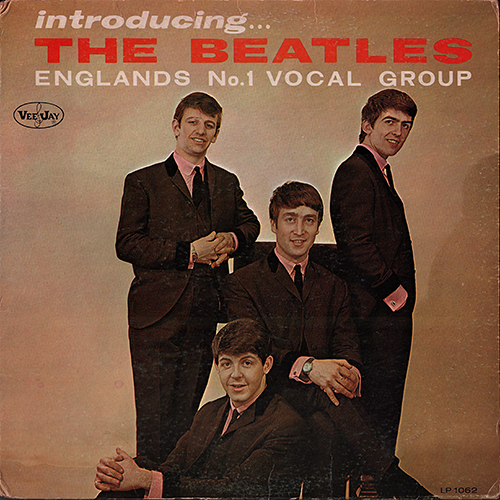 |
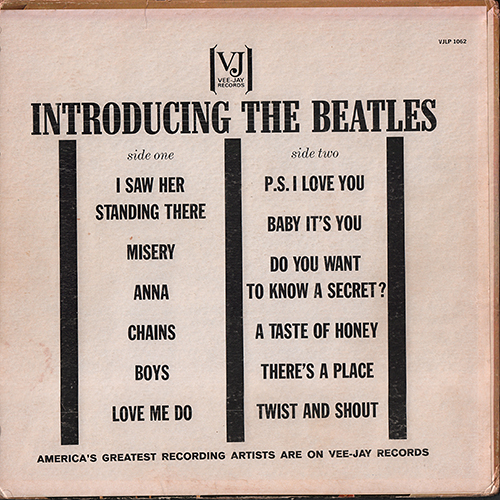 |
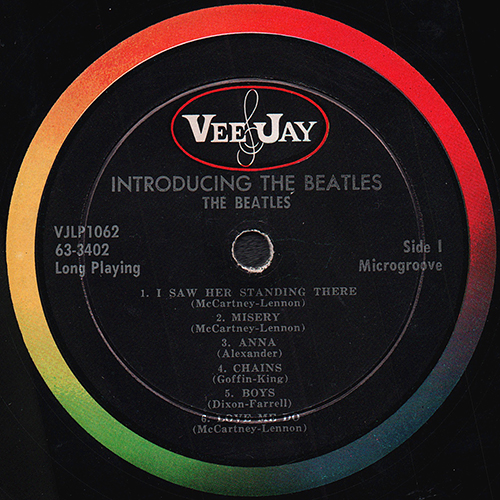 |
 |
 |
|
| INNER SLEEVE |
FRONT AND BACK COVER CLOSE UP | ||||
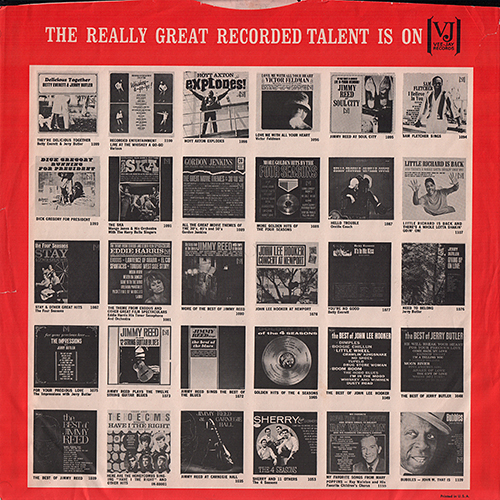 |
 |
 |
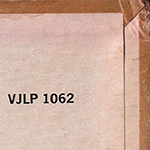 |
Without "Printed in U.S.A." credit on the
front cover. Catalog number "VJLP 1062" was printed at the right corner of the back cover. |
|
| The mono covers have the slick positioned so that the number LP 1062 appears in the lower right hand corner. | |||||
| BACK COVER CLOSE UP | |||||
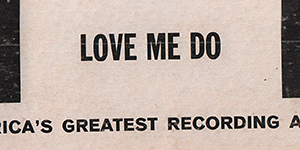 |
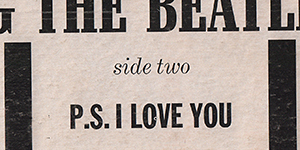 |
This cover has no liner notes or pictures, it does list the song titles in thick black print in two columns. The VJ brackets logo is centered at the top of the cover above the title of the album. | |||
| LABEL CLOSE UP | |||||
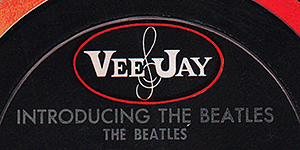 |
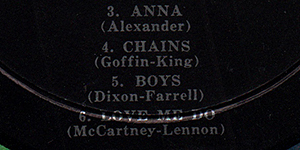 |
It has a black label
featuring an outer rim colorband and the oval logo. Has centered song titles and song- writersf credits with "INTRODUCING THE BEATLES" in medium print |
|||
| LABEL CLOSE UP | |||||
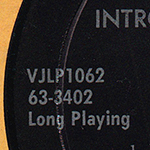 |
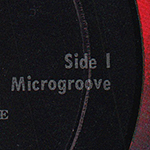 |
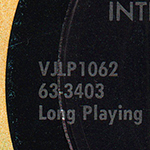 |
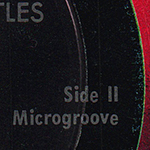 |
"Long Playing" and Side I / Side II above "Microgroove" on the labels. | |
|
OTHER ITEM
|
|||||
| - | |||||
| LABEL | Black label with color band and oval logo Type-1 | ||||
| MIX | MONO |
||||
| PRESS FACTORY |
SLEEVE | Ivy
Hill Lithograph Corp. |
|||
| VINYL |
The American Record Pressing Co. ("ARP") in Owosso, Michigan | ||||
| MATRIX No. | SIDE 1 | 63-3402 A 6-29-63 (hand etched) Audio Matrix and ARP logo (machine stamped) | |||
| SIDE 2 | 63-3403 A RA 6-29-63 (hand etched) Audio Matrix and ARP logo (machine stamped) | ||||
| VINYL COLOR | BLACK | ||||
| PUBLISHER'S NAME |
- |
||||
| COVER FORM | Single type. Housed in a cardboard jacket. |
||||
| PRINTER CREDIT | - |
||||
| COVER DESIGN/ PHOTO/ NOTES | Photo: Angus McBean / The picture
was from a January 1963 photo session (reversed the negative) |
||||
| INNER SLEEVE | Vee-Jay original company sleeve type-2 |
||||
| PRODUCER | George Martin | ||||
|
COMMENTS
|
While British albums
typically had 14 songs, 12 was the magic number in America.
To get down to a dozen songs, Vee-Jay deleted Please Please
Me and Ask Me Why, the groupfs first U.S. single, from its
version of the Beatles first album. With Please Please Me
dropped from the record, there was no reason for Vee- Jay to
name the album Please Please Me. Instead, the album was
named Introducing The Beatles, which was appropriate because
Vee-Jay was, in fact, "introducing the Beatles" to the
American public. "Introducing The Beatles" opens with the hard rocking Lennon-McCartney original "I Saw Her Standing There". The Parlophone discs include Paulfs full gOne, two, three, faaa!h lead count-in, whereas both the mono and stereo versions of the Vee-Jay album pick up the count at four. The title of the album appears at the top of the jacket on two lines as "introducing... THE BEATLES" with the first word in white and the groupfs name in red. This is followed by the phrase "ENGLANDS No.1 VOCAL GROUP" in white to let the American public know of the groupfs popularity in their homeland. The mono covers have the slick positioned so that the number LP 1062 appears in the lower right hand corner. The positioning of the slick on the stereo covers cuts off all of Paulfs arms except for a sliver of his thumbs and exposes a white top banner with "STEREOPHONIC" centered in grey and the number SR 1062 in black in the upper right-hand corner. They used the photo from the The Beatles' Hits EP, chopped off their feet and reversed the negative—meaning their hair was flowing the wrong way. In 1959, Vee-Jay began using Coburn & Company, an offset printing firm in Chicago, to print the front cover slicks and back cover liner notes for its albums. Coburn included the phrase "Printed in U.S.A." either in upper and lower case or in all capital letters on front cover slicks prepared for Vee-Jay. When Vee-Jayfs financial difficulties in the summer of 1963 prevented the company from paying its suppliers, Coburn refused to accept new orders from Vee-Jay in September and sued Vee-Jay for over $50,000 owed on account. This forced Vee-Jay to switch printers. The new printers did not include the phrase "Printed in U.S.A." on their covers. Coburn prepared 6,000 cover slicks for LP 1062. The 6,000 slicks printed by Coburn for Introducing The Beatles were the first slicks used for the album. These slicks are easily identifiable as they have "Printed in U.S.A." running vertically along the left side of the jacket one to two inches from the lower left corner. Additional cover slicks for Introducing The Beatles were not prepared until nearly six months later. By that time, Vee-Jay was no longer using Coburn to print its album covers. This explains why most copies of the album, as well as the other Beatles albums on Vee-Jay, do not have "Printed in U.S.A." on their covers. The later cover slicks for Introducing The Beatles were probably printed by Ivy Hill Lithograph Corp. at its Los Angeles and Great Neck, New York, locations. There are three different variations to the mono and stereo back covers of Version One of Introducing The Beatles. Type-1) The initial LP jackets have back covers that serve as an advertisement for "OTHER FINE ALBUMS OF SIGNIFICANT INTEREST" on Vee-Jay. The back cover slick has miniature color photographs of the covers of 25 Vee-Jay albums. The front cover has the phrase "Printed in U.S.A." running vertically along its lower left side. This variation is known as the "Ad Back" cover. Type-2)The second variation of the albumfs back cover: The second variation is a glossy blank white slick. This variation is known among collectors as the "Blank Back" cover. Blank Back covers (mono and stereo) have two noticeable but minor variations: with "Printed in U.S.A." on its front cover slick. / later front cover slick without "Printed in U.S.A." Type-3)The third back cover variation is much more conventional. Although this cover has no liner notes or pictures, it does list the song titles in thick black print in two columns. The VJ brackets logo is centered at the top of the cover above the title of the album. All Beatles records on Vee-Jay, there are multiple label variations for this historic album. This is because the records were manufactured at different regional pressing plants. Exhibits filed in Vee-Jayfs New York litigation with Capitol indicate that stampers were initially sent to the same three factories that produced the Beatles 1963 singles: ARP, Monarch and Southern Plastics. These factories initially pressed the album with their existing supply of label backdrops with the Vee-Jay oval logo. In order to keep up with the anticipated huge demand for Introducing The Beatles, Vee-Jay arranged for another factory, Allentown Record Co., Inc. (gARCh) in Allentown, Pennsylvania, to press copies of the album. During the early 1960s, Vee-Jay albums were pressed with black label backdrops with an outer rim colorband featuring an oval logo. In January 1964, Ivy Hill Lithograph Corp. in Great Neck, New York, prepared 107,000 album label backdrops featuring the new brackets logo, which were shipped to ARP, Monarch, Southern Plastics and ARC. As the first three companies served as regional factories for Vee-Jay throughout 1963 and had thousands of oval logo label backdrops on hand, their pressings of Version One of Introducing The Beatles were made exclusively with leftover oval logo label backdrops. This was not the case with ARC, which Vee-Jay brought on line in January of 1964 to meet the huge demand for Introducing The Beatles. Since ARC never had any Vee-Jay oval logo label backdrops, all albums pressed by ARC feature the brackets logo. The most common mono record label variation for Version One of Introducing The Beatles: It has a black label featuring an outer rim colorband and the oval logo. There are three typesetting variations. Type-1) Has centered song titles and song- writersf credits with "INTRODUCING THE BEATLES" in medium print and "Long Playing" and "Microgroove" on the label. The trail off areas have the hand-etched matrix number 63-3402 on Side I and 63-3403 on Side II. Both sides have the hand- etched initials "RA" and "A" as well as the machine stamped Audio Matrix and "ARP" logos. The initials gRAh indicate that the metal parts used to press these records were generated from lacquers cut at Universal in Chicago by Roger Anfinsen. This variation was pressed by ARP. Type-2-1)has left justified song titles and songwritersf credits with gINTRODUCING the BEATLESh in small print. The words gLong Playingh and gMicrogrooveh do not appear on the label. The trail off areas have the hand-etched matrix number 63-3402 and job number ∆5702 on Side 1 and matrix number 63-3403 and job number ∆5702-X on Side 2. Both sides have the hand-etched date 6-29-63 and initials gRAh and gAh as well as the machine stamped Audio Matrix and (MR) logos. This vinyl pressing was manufactured by Monarch. Type-2-2)Has the same typesetting and identical trail off area markings as the Monarch pressing, but the label is not the standard size album label. Instead, it is a black label with an outer rim colorband featuring a small oval logo on a 45-size label. Type-3)Has left justified titles and credits, but "INTRODUCING the BEATLES" is in medium print and the words "LONGPLAYING" and "MICROGROOVE" appear on the label. The typesetting on the labels has an amateurish appearance as gTHE BEATLESh is not level, particularly noticeable on Side 1. Its trail off areas have hand-etched matrix numbers as well as the date 6-29-63 and the initials "RA" and "A." The machine stamped Audio Matrix logo is also present. This disc is thicker than the other two variations and was pressed by Southern Plastics. Type-4) The ARC variation (Bracket logo): It has left justified song titles and indented credits with "INTRODUCING the BEATLES," "MICROGROOVE" and "LONGPLAYING." Its trail off areas contain the following hand-etched markings: "AB," the matrix number 63-3402 and the date 1-10-64 on SIDE 1; gA11,h the matrix number 63-3403 and the date 1-11-64 on SIDE 2; and "ARC" on both sides. The Audio Matrix logo is also clearly visible on both sides. Type-5)Has a solid black label featuring a small Vee-Jay brackets logo overprinted in silver at the top. This disc was manufactured by Southern Plastics. |
||||
